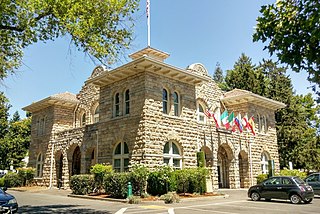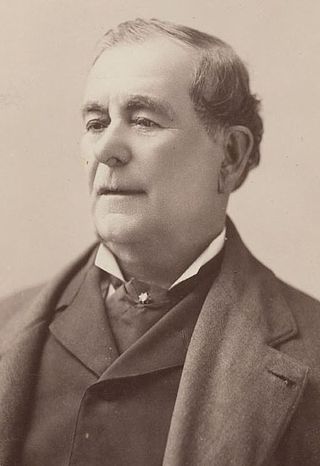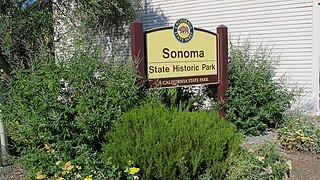
Mission San Francisco Solano was the 21st, last, and northernmost mission in Alta California. It was named for Saint Francis Solanus. It was the only mission built in Alta California after Mexico gained independence from Spain. The difficulty of its beginning demonstrates the confusion resulting from that change in governance. The California Governor wanted a robust Mexican presence north of the San Francisco Bay to keep the Russians who had established Fort Ross on the Pacific coast from moving further inland. A young Franciscan friar from Mission San Francisco de Asis wanted to move to a location with a better climate and access to a larger number of potential converts.

Sonoma County is a county located in the U.S. state of California. As of the 2020 United States Census, its population was 488,863. Its seat of government and largest city is Santa Rosa.

Petaluma is a city in Sonoma County, California, located in the North Bay region of the San Francisco Bay Area. Its population was 59,776 according to the 2020 census.

Santa Rosa is a city in and the county seat of Sonoma County, in the North Bay region of the Bay Area in California. Its population as of the 2020 census was 178,127. It is the largest city in California's Wine Country and Redwood Coast. It is the fifth most populous city in the Bay Area after San Jose, San Francisco, Oakland, and Fremont; and the 25th-most populous city in California.

Sonoma is a city in Sonoma County, California, United States, located in the North Bay region of the San Francisco Bay Area. Sonoma is one of the principal cities of California's Wine Country and the center of the Sonoma Valley AVA. Sonoma's population was 10,739 as of the 2020 census, while the Sonoma urban area had a population of 32,679. Sonoma is a popular tourist destination, owing to its Californian wineries, noted events like the Sonoma International Film Festival, and its historic center.

Don Mariano Guadalupe Vallejo was a Californio general, statesman, and public figure. He was born a subject of Spain, performed his military duties as an officer of the Republic of Mexico, and shaped the transition of Alta California from a territory of Mexico to the U.S. state of California. He served in the first session of the California State Senate. The city of Vallejo, California, is named after him, and the nearby city of Benicia is named after his wife.

The Native Sons of the Golden West (NSGW) is a fraternal service organization founded in the U.S. state of California in 1875, dedicated to historic preservation and documentation of the state's historic structures and places, the placement of historic plaques, and other charitable functions in California. In 1890 the organization placed California's first marker honoring the discovery of gold, which gave rise to the state nickname, "The Golden State". U.S. President Richard M. Nixon and Chief Justice Earl Warren served terms as presidents of the NSGW.

Sonoma Valley is a valley located in southeastern Sonoma County, California, in the North Bay region of the San Francisco Bay Area. Known as the birthplace of the California wine industry, the valley is home to some of the earliest vineyards and wineries in the state, some of which survived the phylloxera epidemic of the 1870s and the impact of prohibition in the early 20th century. Today, the valley's wines are promoted by the U.S. federal government's Sonoma Valley and Carneros AVAs.

The Diocese of Santa Rosa in California is a Latin Church diocese, or ecclesiastical territory, of the Catholic Church in the northern California region of the United States. It is a suffragan diocese of the ecclesiastical province of the metropolitan Archdiocese of San Francisco.
Santa Rosa Junior College (SRJC) is a public community college in Santa Rosa, California with an additional campus in Petaluma and centers in surrounding Sonoma County. Santa Rosa Junior College was modeled as a feeder school for the University of California system. SRJC is governed by the Sonoma County Junior College District (SCJCD).

Sonoma State Historic Park is a California State Park located in the center of Sonoma, California. The park consists of six sites: the Mission San Francisco Solano, the Sonoma Barracks, the Blue Wing Inn, La Casa Grande, Lachryma Montis, and the Toscano Hotel.

Brainerd Jones was an American architect who designed and built most of the architecturally-significant buildings in Petaluma, California.

The Petaluma and Santa Rosa Railway Power House is a historic building in Sebastopol, California, U.S., built to serve the Petaluma and Santa Rosa Railroad, an electric interurban railway of Sonoma County. It is also known as the Hogan Building and the P&SR Substation. It was listed on the National Register of Historic Places in 1991.

The Sonoma County Library is a medium-sized public library system that serves the nine cities and unincorporated areas of Sonoma County, California. The library system is a joint powers authority, with administration located at the Administrative Offices, 6135 State Farm Dr, Rohnert Park, CA 94928.

Doña María Ygnacia López de Carrillo was a Californio ranchera. She was the founder of Santa Rosa. She married into the prominent Carrillo family of California and was the ancestor of numerous prominent Californians.

The Sonoma Barracks is a two-story, wide-balconied, adobe building facing the central plaza of the City of Sonoma, California. It was built by order of Mariano Guadalupe Vallejo to house the Mexican soldiers that had been transferred from the Presidio of San Francisco in 1835. The Presidio Company and their commander, Vallejo, were also responsible for controlling the Native Americans living on the northern border of Mexican California.

Tubbs Island is an island in San Pablo Bay. It is in Sonoma County, California, and parts of it are managed as part of the Napa-Sonoma Marshes Wildlife Area. Its coordinates are 38°08′59″N122°25′27″W, and the United States Geological Survey measured its elevation as 0 ft (0 m) in 1981. It, long with Island No. 1, Island No. 2 and Green Island, are labeled on a 1902 USGS map of the area.
The Superior Court of California, County of Sonoma, also known as the Sonoma County Superior Court or Sonoma Superior Court, is the California superior court with jurisdiction over Sonoma County.

Sonoma Grammar School is a historic building located in Sonoma, California. Founded in 1916, it stands as the largest brick building in Sonoma. In 1952, the building was saved from demolition and is now the home of the Sonma Community Center. The Sonoma Grammar School was added to the National Register of Historic Places on November 28, 1980.

Sonoma City Hall is a historic municipal government building located in the Sonoma Plaza in Sonoma, California. Dedicated on September 9, 1908, the building holds historical significance for the community and serves as the city's administrative center.






















